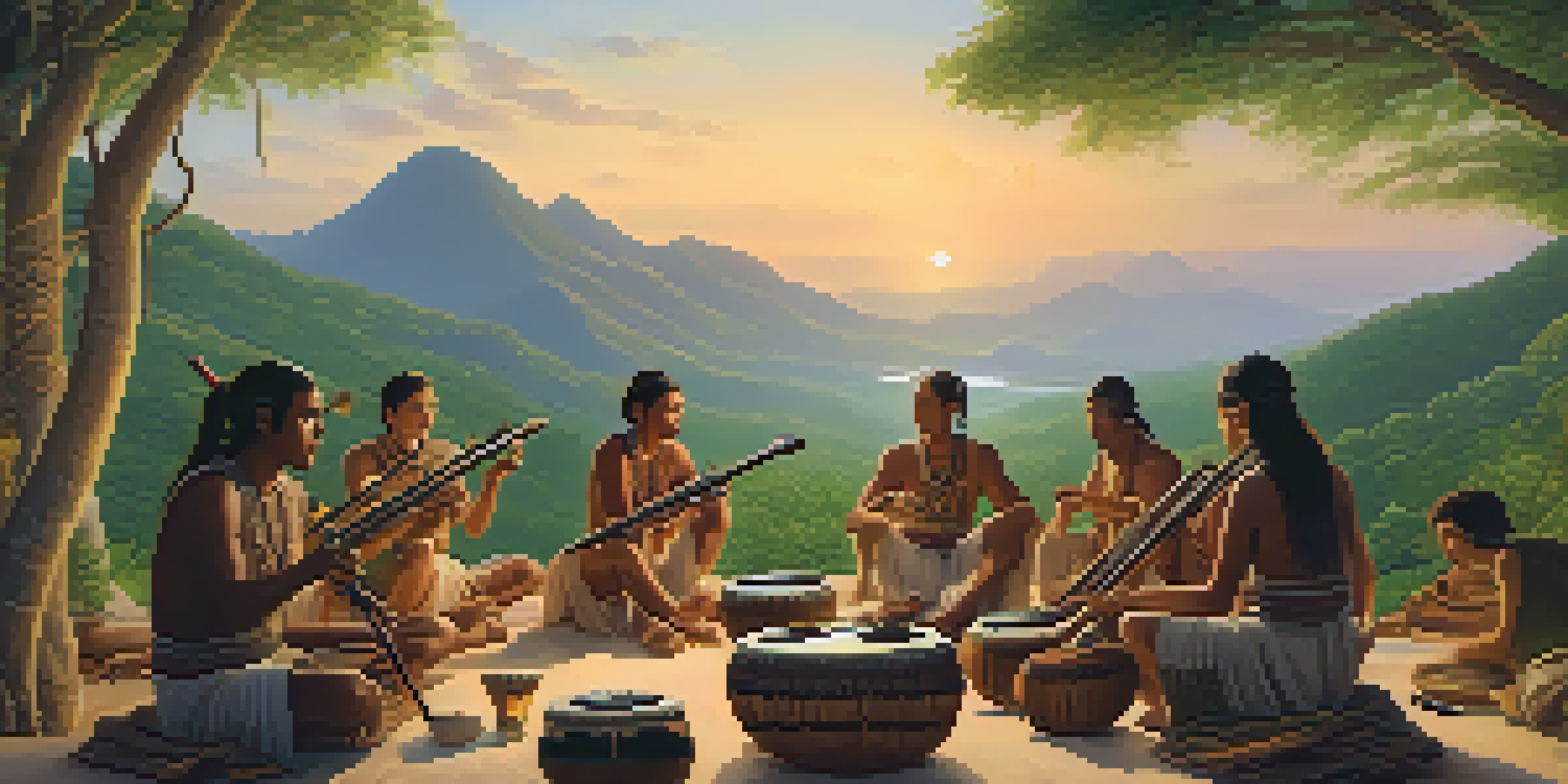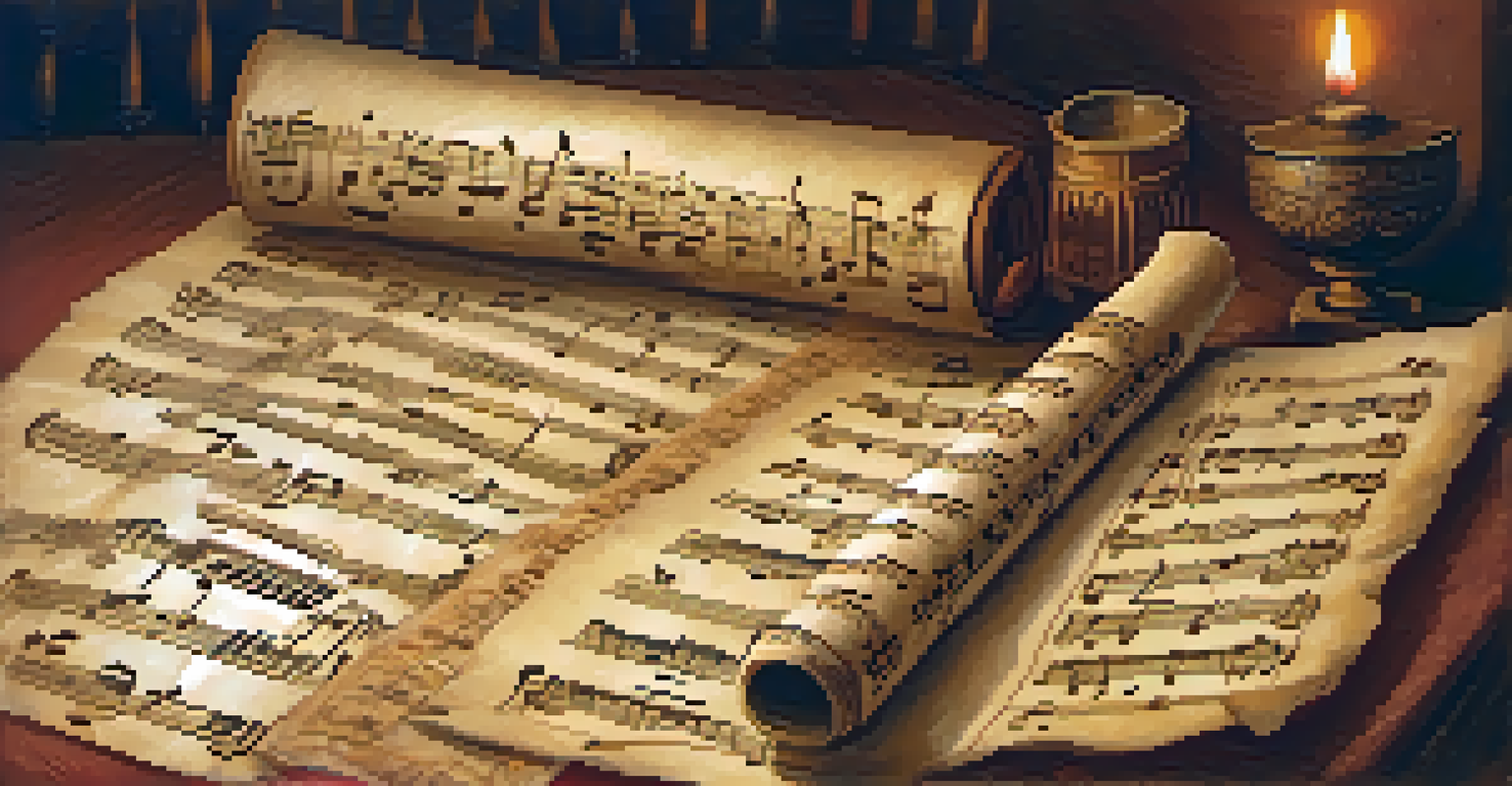The Evolution of Music Composition: Historical Perspectives

Ancient Roots: The Beginnings of Music Composition
The origins of music composition can be traced back to ancient civilizations, where music was integral to rituals and storytelling. Instruments like flutes made from bones and early percussion instruments formed the backbone of early musical expression. These primitive sounds laid the groundwork for more complex compositions as societies evolved and storytelling became more sophisticated.
Music can change the world because it can change people.
In ancient Mesopotamia, music was often notated using cuneiform tablets, highlighting an early attempt at preserving musical ideas. This marked a significant shift from oral traditions to written records, allowing composers to share their creations across generations. As a result, the ancient world saw the emergence of music as a form of art that transcended mere entertainment.
Furthermore, ancient Greece contributed significantly to music theory, with philosophers like Pythagoras exploring the mathematical foundations of sound. This intellectual curiosity paved the way for a deeper understanding of harmony and melody, elements that are still crucial in music composition today.
The Middle Ages: The Rise of Notation Systems
The Middle Ages, spanning from the 5th to the 15th century, brought about significant advancements in music notation. The development of neumes, the earliest form of musical notation, helped codify melodies for the first time, allowing music to be shared and preserved more effectively. This period marked the transition from purely oral traditions to a more structured approach to music composition.

During this time, the church played a pivotal role in music, with Gregorian chant becoming a staple of medieval worship. Composers began to explore polyphony, where multiple independent melodies were sung simultaneously, enriching the musical landscape significantly. This experimentation with different musical lines laid the groundwork for the complex harmonies that would emerge in later periods.
Music's Evolution Through History
Music composition has evolved from ancient rituals to complex forms, reflecting cultural and societal changes over centuries.
Additionally, the invention of the printing press in the 15th century revolutionized music distribution. Music could be printed and disseminated widely, making it accessible to a broader audience and enabling composers to reach new heights in their creative endeavors.
The Renaissance: A Flourishing of Musical Innovation
The Renaissance era, spanning the 15th to the 17th century, is often viewed as a golden age for music composition. This period saw an explosion of creativity, with composers like Josquin des Prez and Palestrina pushing the boundaries of musical expression. Their works emphasized clarity of text and emotional depth, which resonated with audiences and influenced future generations.
Without music, life would be a mistake.
The use of harmony became more sophisticated during the Renaissance, leading to the development of the modal system. Composers began to explore new scales and harmonies, resulting in a rich tapestry of sound that captivated listeners. This experimentation paved the way for the emergence of the major-minor tonal system, which would dominate Western music for centuries to come.
Moreover, the rise of instrumental music during this period cannot be overlooked. As composers began to write specifically for instruments, a new realm of musical possibilities emerged, setting the stage for the Baroque period and beyond.
The Baroque Period: Complexity and Ornamentation
The Baroque period, from the late 16th to the mid-18th century, is characterized by its complexity and ornamental style. Composers like Johann Sebastian Bach and George Frideric Handel introduced intricate counterpoint and elaborate ornamentation in their compositions. This era emphasized expressive melodies, often conveying deep emotional narratives through music.
The development of opera during this time marked a significant evolution in music composition. This new genre combined music, drama, and visual art, creating an immersive experience for audiences. Composers began to experiment with musical forms, leading to the rise of the aria and recitative as distinct components of opera.
The Impact of Notation Systems
The development of notation systems during the Middle Ages allowed music to be preserved and shared, transforming how composers approached their craft.
Furthermore, the emergence of the concerto and sonata forms allowed for even more dynamic expressions of musical ideas. These structures provided a framework for composers to showcase their creativity, leading to a wealth of innovative works that continue to inspire musicians today.
The Classical Era: Simplicity and Clarity
The Classical era, spanning from the mid-18th to the early 19th century, shifted the focus toward simplicity and clarity in music composition. Composers like Wolfgang Amadeus Mozart and Joseph Haydn emphasized balanced forms and clear structures, which made their music more accessible to audiences. This period is often seen as the height of musical elegance and refinement.
Symphonies and string quartets became popular during this time, allowing composers to explore new textures and orchestral colors. The development of sonata form provided a solid foundation for many compositions, promoting thematic development and variation. This emphasis on form and structure led to a greater understanding of musical storytelling.
Additionally, the Classical era set the stage for the Romantic period by allowing composers to express personal emotions and ideas more freely. The groundwork laid during this time would have a lasting impact on music composition in the years to come.
The Romantic Era: Emotion and Individual Expression
The Romantic era, flourishing in the 19th century, marked a dramatic shift towards emotional expression in music composition. Composers like Ludwig van Beethoven and Franz Liszt brought their personal experiences and feelings into their music, creating powerful emotional narratives. This emphasis on individual expression resonated deeply with audiences, leading to a rich and diverse musical landscape.
During this time, the use of thematic transformation became popular, allowing composers to develop motifs throughout their works. This technique added depth and complexity to compositions, inviting listeners on a journey through various emotions and ideas. The Romantic period also saw the rise of nationalistic elements, as composers began to incorporate folk melodies and rhythms into their works.
Innovation in the 20th Century
The 20th century saw a surge of innovation in music composition, with diverse styles emerging that challenged traditional boundaries and embraced technology.
Moreover, the expansion of orchestras allowed for more dynamic and varied compositions. The increased range of instruments enabled composers to experiment with new sounds and textures, resulting in some of the most memorable and evocative music in history.
20th Century and Beyond: Innovation and Diversity
The 20th century ushered in a wave of innovation in music composition, with composers exploring a myriad of styles and techniques. From the rise of jazz and blues to the advent of electronic music, the landscape of music became increasingly diverse. Composers like Igor Stravinsky and John Cage challenged traditional notions of music, pushing boundaries and redefining what music could be.
The introduction of minimalism, with composers like Steve Reich and Philip Glass, highlighted the beauty of repetition and gradual transformation in music. This movement shifted the focus away from complex harmonies and elaborate forms, allowing listeners to experience music in a new, meditative way. Such innovations paved the way for contemporary genres, influencing popular music and experimental art.

As we move forward into the 21st century, technology continues to play a crucial role in music composition. Digital tools and software have made it possible for composers to create and distribute their work more easily than ever before, leading to an explosion of creativity across genres. The evolution of music composition remains a vibrant tapestry, reflecting the complexities of human experience and emotion.